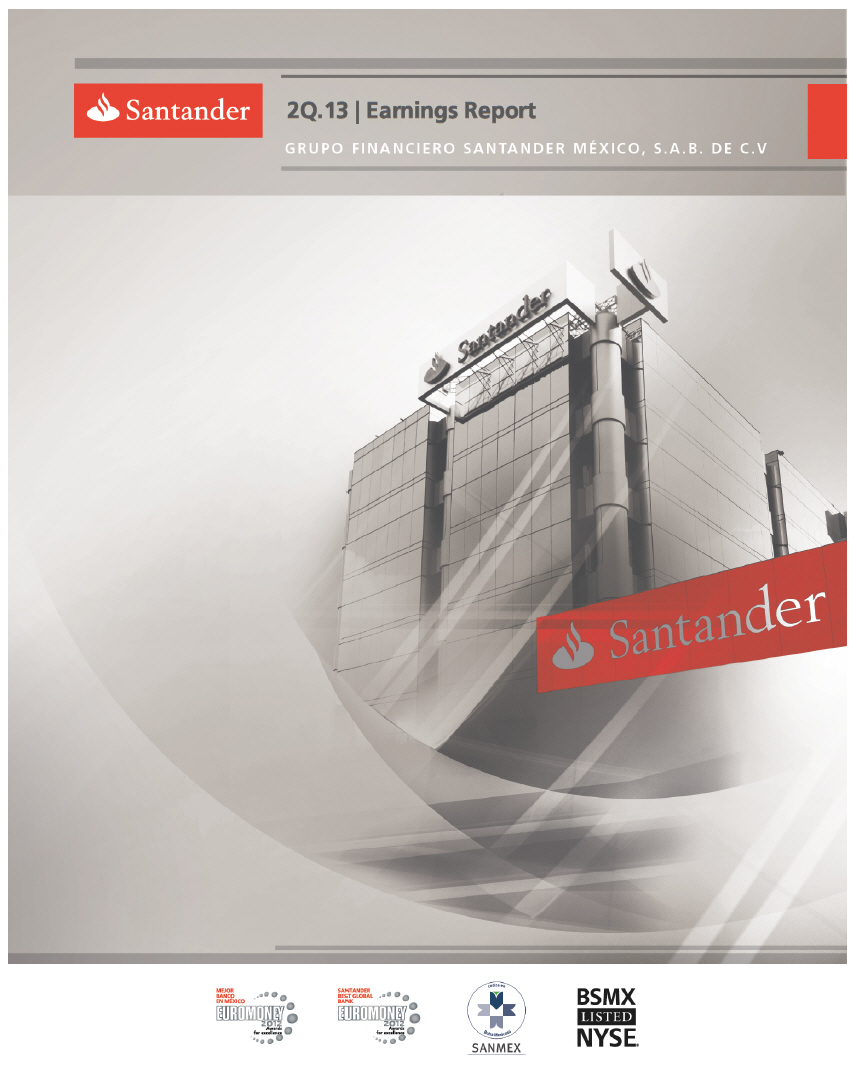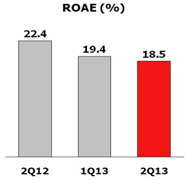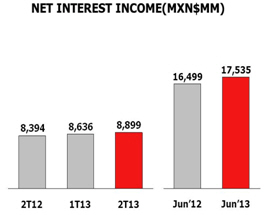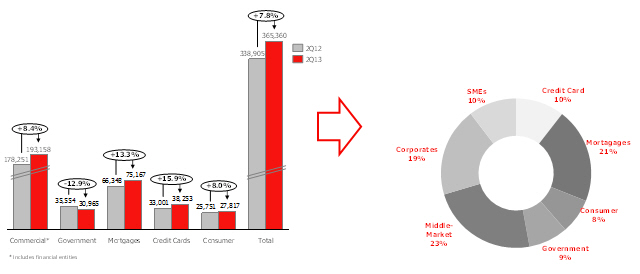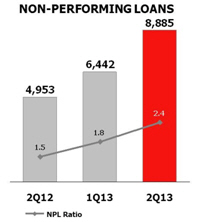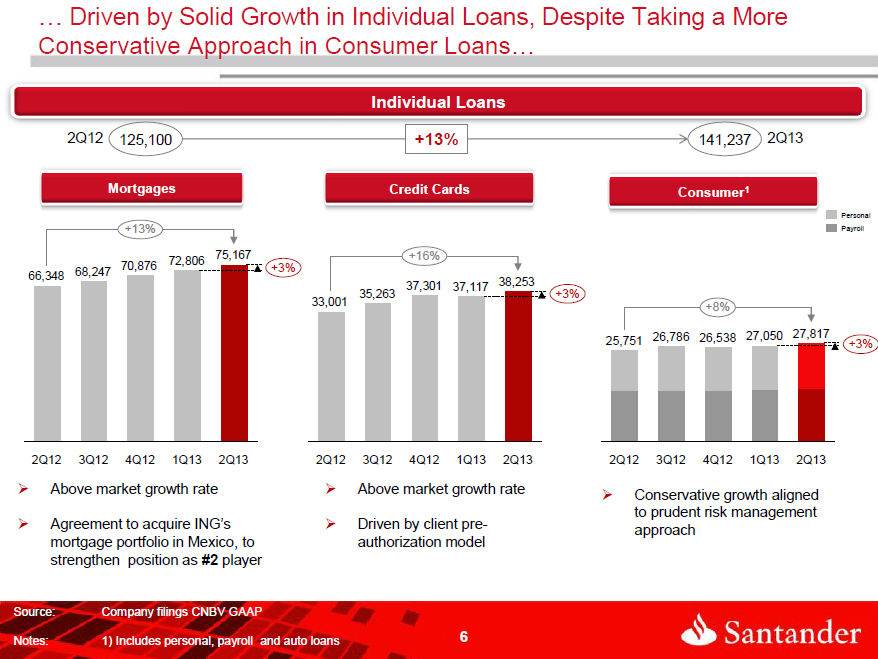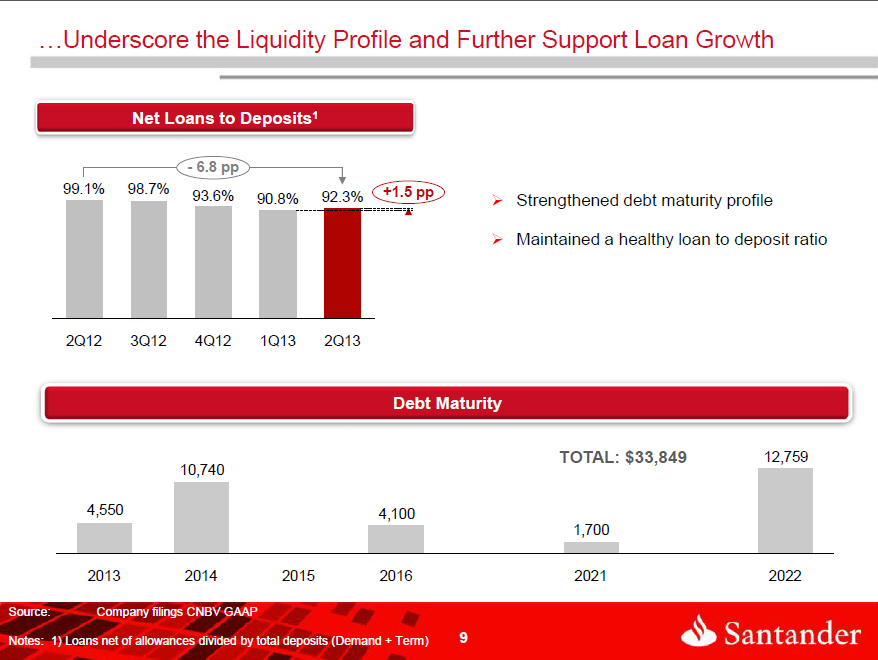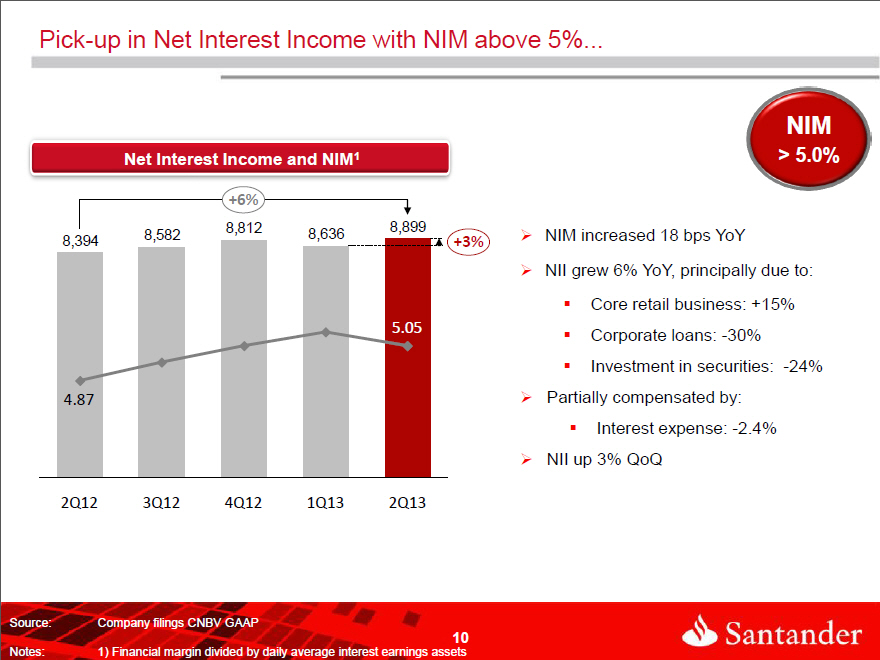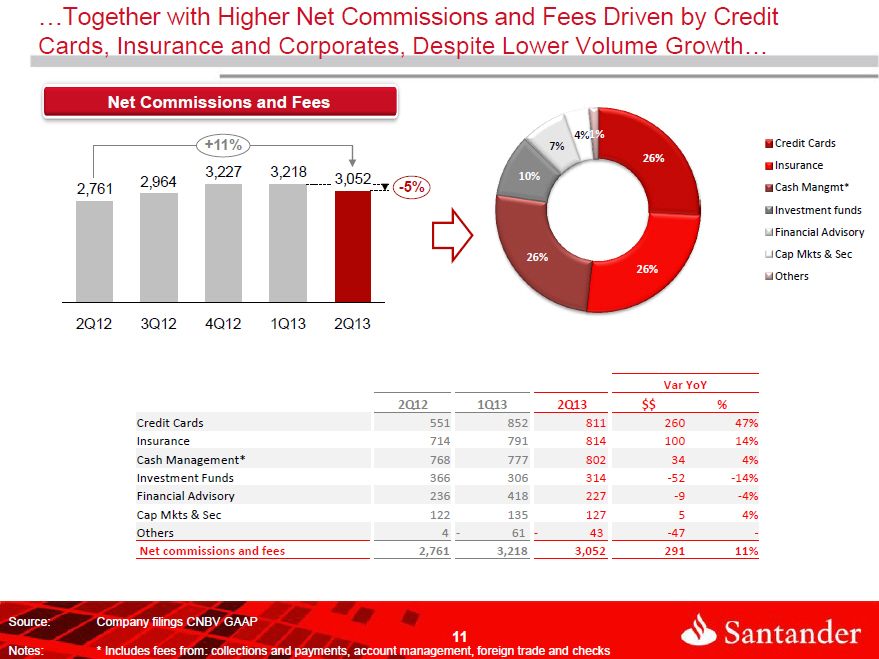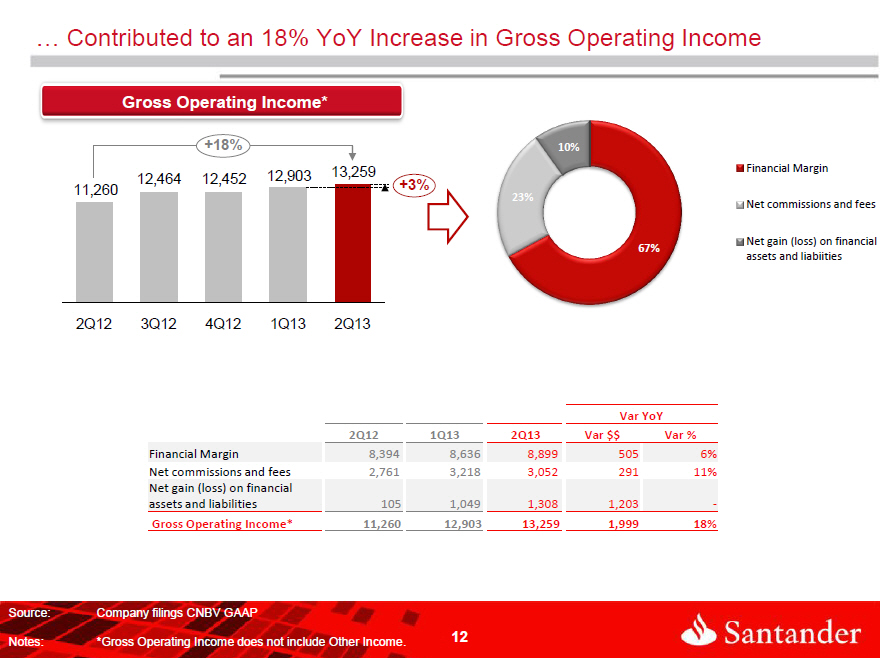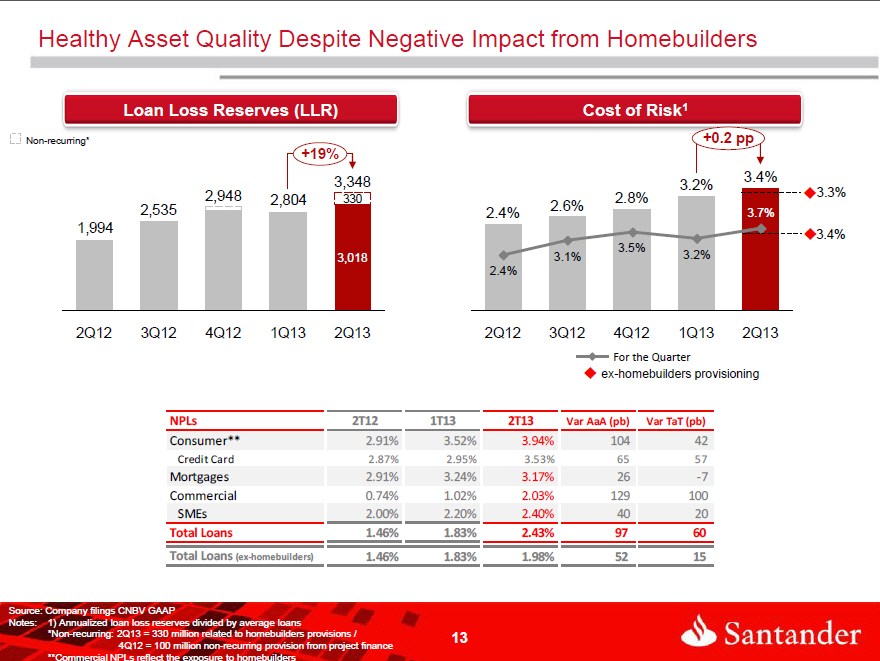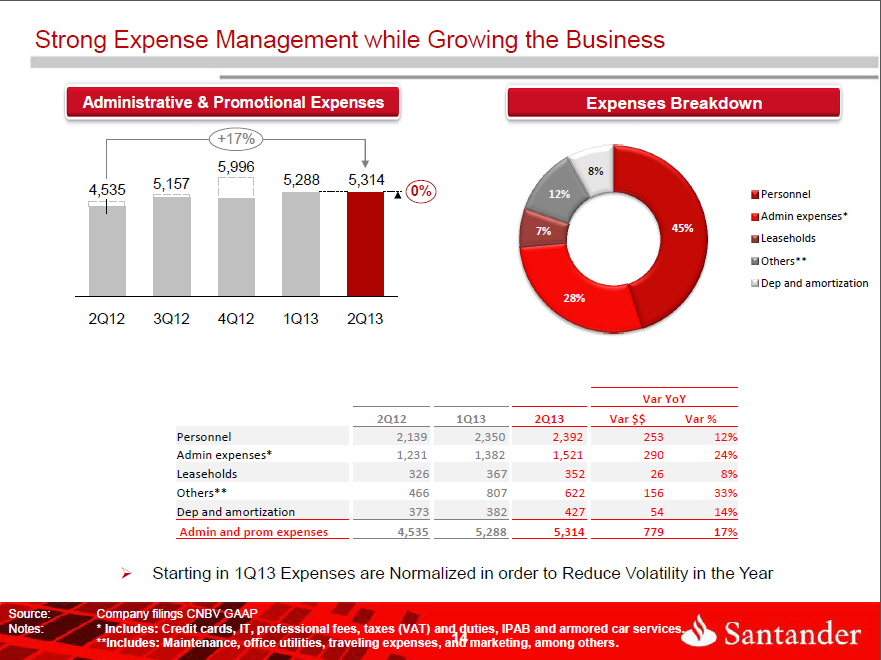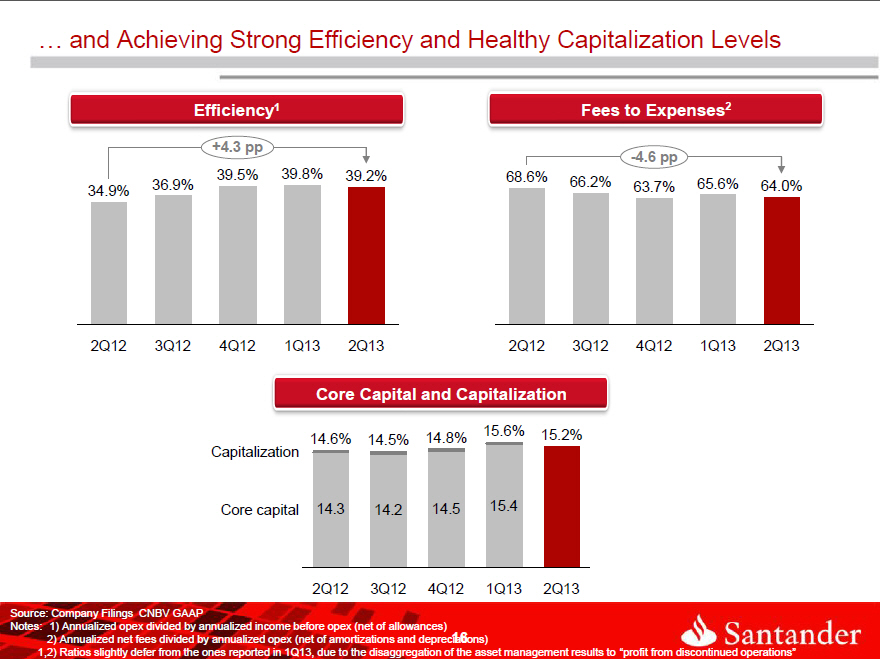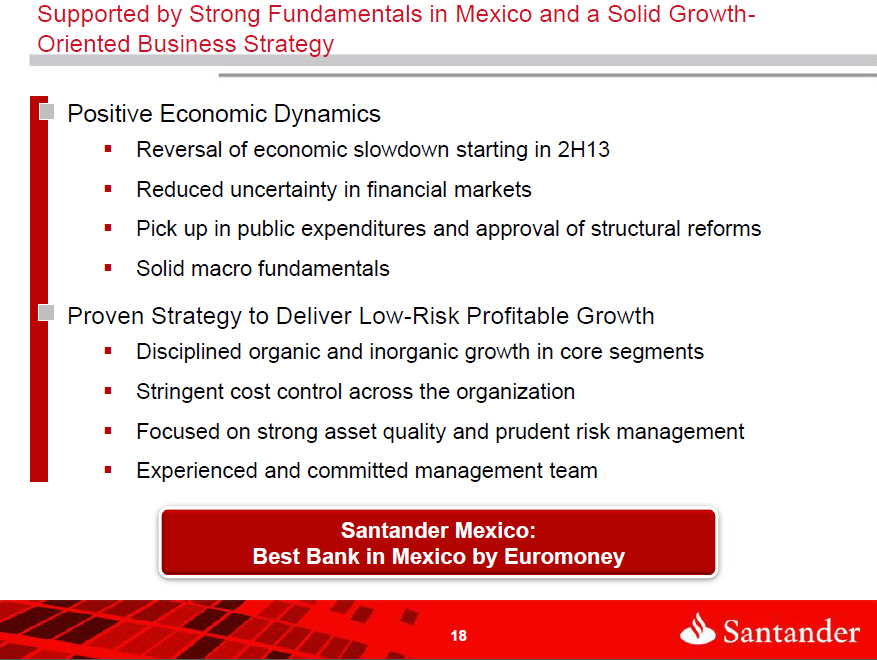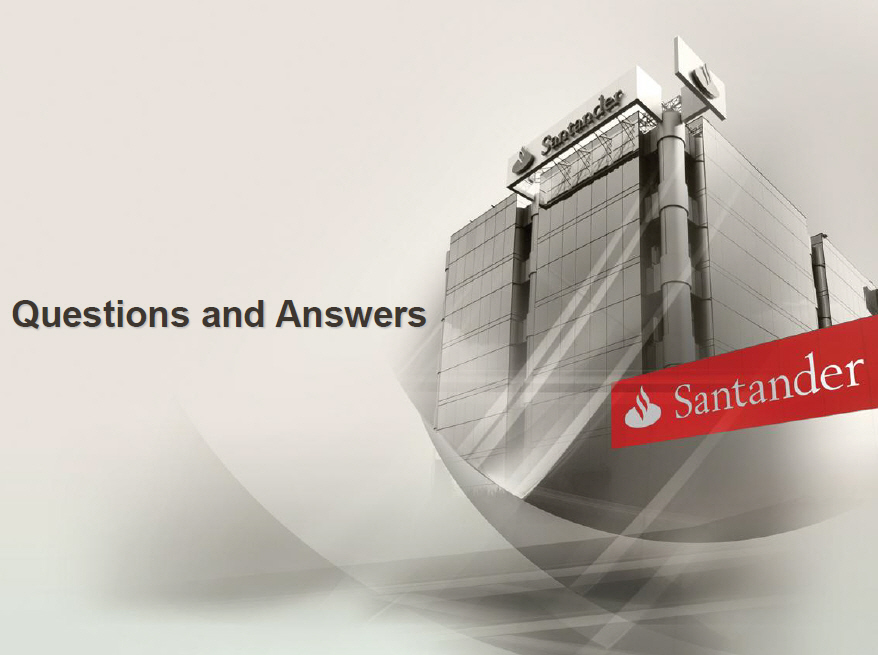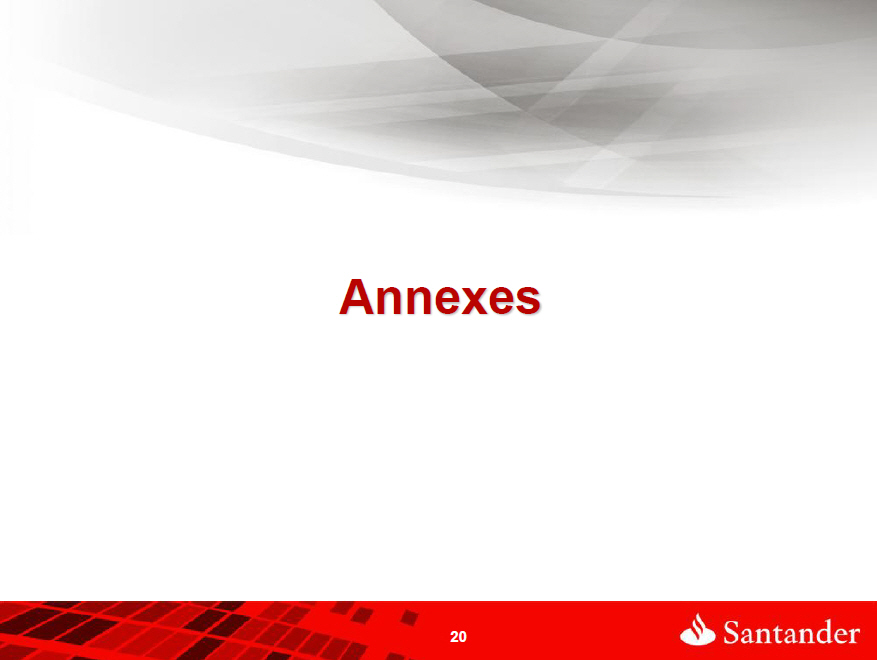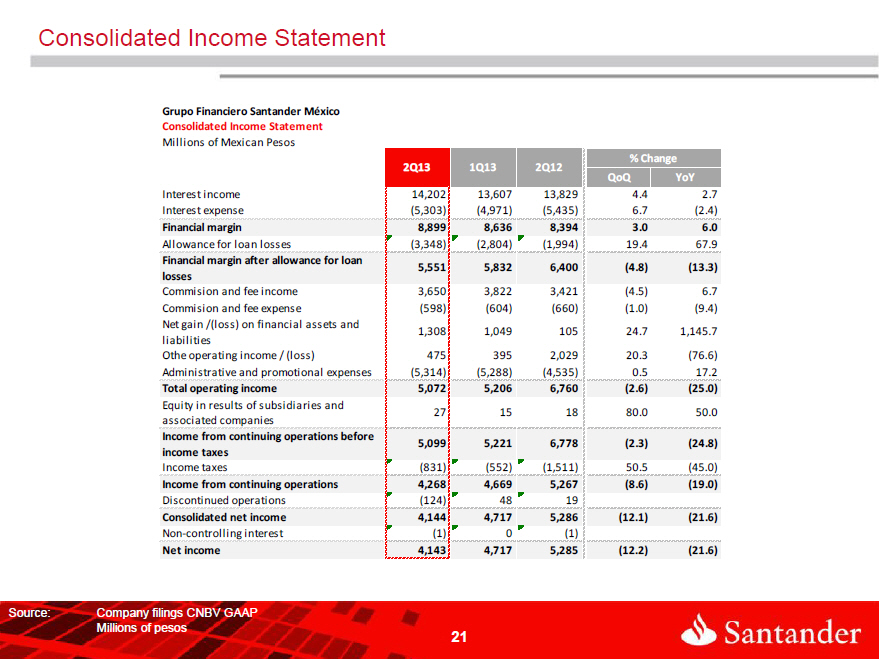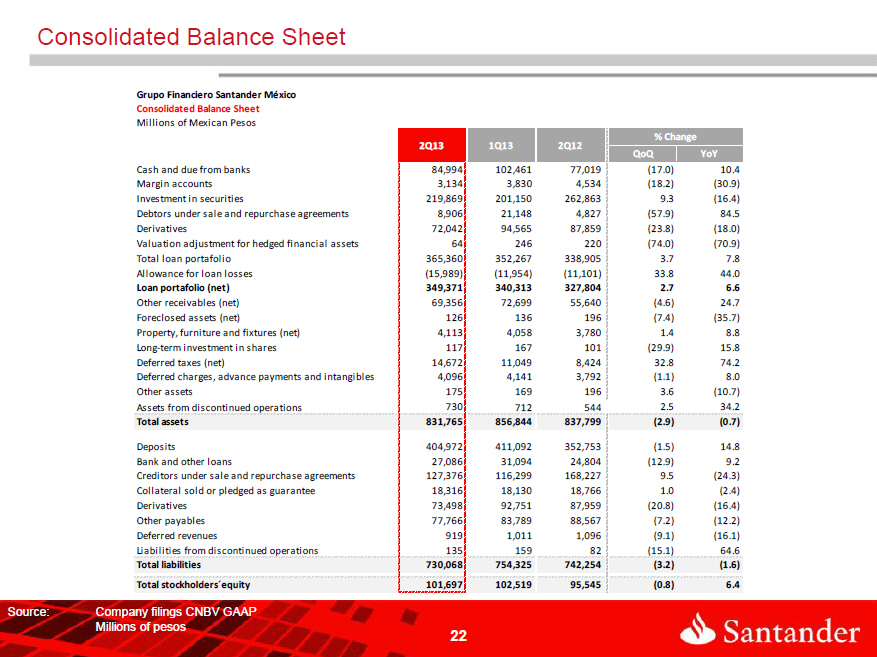Grupo Financiero Santander México,
S.A.B. de C.V.
Complementary information for the Second Quarter of 2013,
in compliance with the obligation of reporting transactions with derivative
financial instruments.
| 2Q.13 | Comprehensive Risk Management | 1 |
 |
III. Qualitative and Quantitative Information
i. Management of policies on the use of derivative financial instruments.
The policies of the Institution allow the use of derivative products for hedging and/ or trading purposes.
The main objectives of the transactions with these products are for hedging risks and maximization of profitability.
The Institution uses the following instruments:
Forwards
Futures
Options
Swaps
Swaptions
Depending of the portfolios, strategies to be implemented may be for hedging or trading purposes.
Trading markets:
Exchange-traded
Over the Counter
Eligible counterparties: domestic and foreign counterparties having internal approvals.
The appointment of calculation agents is carried out in the legal documents dully executed by the parties. For the valuation of the instruments, the prices published by authorized Suppliers of Prices are used.
The main terms or conditions of the agreements are based in international ISDA or the domestic standard agreement.
Specific policies on margins, collaterals and credit lines are detailed in the internal manuals of the Institution.
Comprehensive Risk Management
Risk management is considered by Grupo Financiero Santander as a competitive element of strategic nature with the purpose of maximizing the value for the stockholder. This management is defined, from a conceptual and organizational sense, as a comprehensive management of the different risks (market risk, liquidity risk, credit risk, counterparty risk, operative risk, legal risk and technological risk) assumed by the institution for the development of its activities. The management of the risk inherent to transactions is essential for understanding and determining the behavior of the financial condition of the institution and the creation of long-term value.
In order to comply with the provisions regarding the Comprehensive Risk Management applicable to credit institutions, issued by the National Banking and Exchange Commission, the Board of Directors agreed to create the Comprehensive Risk Management Committee of the institution, to work pursuant to the rules set by such regulations. This Committee gathers every month and verifies that the transactions are according to the objectives, policies and procedures approved by the Board of Directors for the Comprehensive Risk Management.
The Comprehensive Risk management Committee delegates in the Comprehensive Risk Management Unit the responsibility for the implementation of procedures for the measure, administration and control of risks according to
| 2Q.13 | Comprehensive Risk Management | 2 |
 |
the applicable policies; such Unit has the faculty to authorize amounts greater than the stipulated limits and in such cases, the Board of Directors shall be informed on such deviations.
Market Risk
The Market Risk Management department of the Comprehensive Risk management Unit is responsible for recommending the policies on market risk management of the institution, and to establish the parameters for risk measuring, and to provide reports, analysis and assessments to the senior management, to the Comprehensive Risk Management Committee and to the Board of Directors.
Market risk management consists in identifying, measuring, monitoring and controlling risks arising from fluctuations in the interest rates, FX rates, market prices and other risk factors in money markets, capital markets and derivatives markets in which the institution is exposed by its position.
The market risk measurement quantifies the potential variation in the value of the positions as a consequence of changes in the market risk factors.
Depending on the nature of the activities of each business unit, debt and capital instruments are registered as securities for trade, securities available for sale and/or securities held to maturity. The main characteristic that identifies securities available for sale as such is their permanent nature and they are managed as a structural part of the balance sheet. The institution has established provisions that all securities available for sale must fulfill, as well as adequate controls for assuring the compliance of such provisions.
Whenever significant risks are identified, they are measured and limits are allocated in order to assure an adequate control. Global measurement of risk is carried out via a combination of the methodology applied to Portfolios for Trade and to the management of Assets and Liabilities.
Portfolios for Trade
In order to measure the risk in a global approach, the methodology of Value at Risk (VaR) is used. VaR is defined as the statistical estimate of the potential loss of value of a given position, during certain period and at certain confidence level. VaR provides a universal measure of the level of exposure of the different risk portfolios; it allows the comparison of the risk level assumed in different securities and markets and expresses the level of each portfolio through a unique figure in economic units.
VaR is calculated via historical simulation, with a 521 working-days window (520 percentage changes) and a one-day horizon. The calculation is performed from a series of simulated gains and losses with 1% percentile at constant pesos and with pesos decreasing on an exponential basis, with a decrease factor that is reviewed on annual basis, the most conservative measure is the one to be reported. A confidence level of 99% is assumed.
It is important to mention that a limitation of the historical simulation method is that the recent past will reproduce itself in the near-future.
Likewise, monthly simulations of gains or losses of portfolios are carried out by revaluating such portfolios under different scenarios (Stress Test). Such estimates are generated using two different
methods:
| | § | Applying to risk factors the percentage changes observed in certain periods including relevant market turbulences. |
| | § | Applying to risk factors changes that depend on the volatility of each risk factor. |
On a monthly basis “back testing” is carried out to compare daily gains and losses that would have been observed is the same positions had been maintained, taking into account only the change in value at risk in order to be able to fine tune the models. Even though these reports are prepared on a monthly basis, they include daily tests.
| 2Q.13 | Comprehensive Risk Management | 3 |
 |
Management of Assets and Liabilities
Commercial banking activities of the institution generate important balance sheet amounts. The Assets and Liabilities Committee (ALCO) is responsible for determining the guidelines for the management of financial margin risk, net worth value and liquidity that must be followed by the different commercial portfolios. Pursuant to this approach, the General Direction of Finances has the responsibility to execute the strategies defined by the Assets and Liabilities Committee in order to modify the risk profile of the commercial portfolio by following the corresponding policies. Compliance with information requirements for interest rate, Exchange rate and liquidity risks is fundamental.
As part of the financial management of the institutions, sensitivity to financial margin (NIM) and net worth value (MVE) of the different balance sheet items is analyzed in comparison to variations in interest rates. This sensitivity is derived from the difference between maturity dates of assets and liabilities and the dates interest rates are modified. The analysis is performed from the classification of each item sensitive to interest rate throughout time, according to their repayment, maturity or contractual modification of the applicable interest rate.
Using simulation techniques, the predictable value of the financial margin and the net worth value are measured in different interest rate scenarios, and their sensitivity under extreme movement of such scenarios. As of June 2013:
| MM MXP | Sensitivity 1% NIM | | Sensitivity 1% MVE |
| Bank and Brokerage | Total | Derivatives | Non Derivatives | | Total | Derivatives | Non Derivatives |
| Balance MXN GAP | 965 | 82 | 883 | | - 2.405 | 1,003 | - 3,408 |
| Balance USD GAP | 4 | - 3 | 8 | | - 0 | - 51 | 50 |
The Assets and Liabilities Committee adopts investment and hedging strategies in order to maintain such sensitivities within the target range.
Limits
Limits are used to control global risk of the financial group derived from each portfolio and books. The structure of limits is used to control exposures and to establish the total risk authorized to business units. These limits are established for VaR, Loss alert, maximum loss, equivalent volume of interest rate, delta equivalent in variable interest, open foreign currency positions, sensitivity of financial margin and sensitivity of net worth value.
Liquidity Risk
Liquidity risk is related to the ability of the institution to finance acquired commitments at reasonable market prices, as well as to fulfill business plans with stable financing sources. Risk factors may be external (liquidity crisis) and internal due to excessive concentration of maturities.
The institution carries out a coordinated management of maturities of assets and liabilities, and oversees the maximum timing difference profiles. This monitoring is based in the analysis of maturities of assets and liabilities, both contractual and managerial. Liquidity Risk is limited in terms of an accrued liquidity level during one month and in terms of a stipulated liquidity ratio.
Liquidity Gap
The following table shows the liquidity GAP of different maturities as of June, 2013:
| Millions of MXP | Total | 1D | 1W | 1M | 3M | 6M | 9M | 1Y | 5Y | < 5Y |
| | | | | | | | | | | |
| Structural GAP | 97,830 | -4,905 | 63,271 | -11,635 | -16,226 | 30,310 | 13,049 | 25,417 | -11,772 | 10,322 |
| Non Derivatives | 96,681 | -4,777 | 63,362 | -10,613 | -14,959 | 30,286 | 12,723 | 24,754 | -13,942 | 9,847 |
| Derivatives | 1,150 | -128 | -91 | -1,023 | -1,267 | 24 | 327 | 663 | 2,170 | 475 |
| 2Q.13 | Comprehensive Risk Management | 4 |
 |
Credit Risk
Management of credit risk of the Institution is developed differently for the different segments of clients along the three phases of the credit process: acceptance, follow-up and recovery.
From a global perspective, management of credit risk in the institution is responsible for the identification, measurement, integration and assessment of the aggregated risk and the profitability according to such risk; with the purpose of oversee the levels of risk concentration and to adapt them to the limits and objectives previously established.
Risks receiving an individual treatment (risks with companies, institutions and financial entities) are identified and taken apart from those other risk that are managed in standardized manner (consumer and mortgages credits to individuals, loans to businesses and small enterprises)
Risks managed on individual basis are subject to a specific solvency or rating system with a related probability of default that allows the measuring of the risk for each client and for each transaction from the beginning. The assessment of the client, after analyzing other relevant risk factors in different areas, is adjusted according to the special characteristics of the transaction (guarantee, term, etc.)
Standardized risks require, due to their special characteristics (great number of transactions for relatively low amounts), a different management that allows an efficient process and effective use of resources, so automated decision tools are used (expert and credit scoring systems).
Management of loans to companies is complemented, during the follow-up phase, with the so called “system of special monitoring” that determines the policy to be followed in the management of the risks with companies or groups rated within such category. Different situations of levels of monitoring are identified and generate different actions. A special monitoring grade is given in the case of alert signals, systematic reviews, or specific initiatives promoted by the Risks Department or Internal Audit.
Recovery Units constitute a critical element in the management of irregular risk, in order to minimize the final loss for the institution. These units are responsible for a specialized management of the risk from the moment they are classified as irregular risk loans (defaulting payment).
The institution has carried out a policy for the selective growth of risk and a strict treatment of late payments and the creation of the corresponding provisions, based in the prudent criteria defined by the Group.
Probability of Default and Expected Losses
Pursuant to the provisions on Comprehensive Risk Management included in the general regulations applicable to credit institutions, as part of the credit risk management, credit institutions must determine the probability of default. The system allows the calculation of the probability for the different loans portfolios:
| a. | The probability of default (PD) for “No Retail” portfolios is determined via the fine tune of the ratings of clients in a given moment, based in the Monthly Default Rates observed during a period of five years. Such Default Rates are adjusted to an economic cycle of ten years. For “Retail” portfolios, the standard default probabilities set by the Basel Convention are used. |
| b. | Once the probability of default is determined, the parameters of “severity of Loss” (LGD) and “Exposure at Default” (EAD) stipulated in Basel, are taken into consideration. |
Once the abovementioned factors are obtained, the Expected Loss (PE) is calculated as follows:
Expected Loss = Probability of Default x Severity of Loss x Exposure at Default
i.e.: PE = PD * LGD * EAD
| 2Q.13 | Comprehensive Risk Management | 5 |
 |
Counterparty Risk
Included in the credit risk, there is a concept that, due to its characteristics, it requires a special management: the Counterparty Risk.
Counterparty Risk is the risk the Institution assumes with governmental entities, financial institutions, corporations, companies and individuals in their treasury activities and correspondent bank activities. The measurement and control of the Credit Risk in Financial Instruments, Counterparty Risk, is carried out by a special unit with an organizational structure independent from the business areas.
The control of Counterparty Risk is performed daily via the Kondor Global Risk (KGR) system, which informs the credit line available with any counterparty, in any product of the financial markets as well as the maximum term approved.
For the control of the counterparty lines the Equivalent Credit Risk (REC) is used. REC is an estimate of the potential loss if the counterparty stops complying with its payment obligations. REC takes into account ratios per product for measuring the potential risk and includes the current exposure with each counterpart; in consequence, REC varies depending on the type of product and term of transaction.
Equivalent Credit Risk (REC) is defined as the amount the Bank may loss in transactions with active clients if such client does not comply with his/her obligations. A position measured via REC may be constituted by several individual transactions, in different products and different maturity dates, and the total REC for each transaction represents the global position with each counterpart.
Equivalent Credit Risk (REC) is an estimate of the amount the Institution may lose in current transactions with certain counterparty, if such counterparty commits a default in any moment until the maturity date of transactions. REC takes into account the Current Credit Exposure, which is defined as the cost to substitute the transaction at market value provided that this value is positive for the institution, and it is measured as the market value (mark to market) of the transaction (MtM).
In addition, REC includes the Potential Credit Exposure or Potential Additional Risk (RPA), which represents the possible evolution of the current credit exposure until maturity, given the characteristics of the transaction and the possible variations in the market factors. Gross Equivalent Credit Risk considers all the definitions previously described, excluding credit risk reduction because of netting or because of collateral agreements.
For the calculation of Net REC, mitigating factors of the counterparty credit risk are taken into consideration, such as collaterals, netting agreements, among other. The methodology continues to be effective.
In addition to the Counterparty Risk, there is the Settlement Risk, which is present in every transaction at its maturity date, when the possibility that the counterparty does not comply with its payment obligations arises, once the institution has complied with its obligations by issuing payment directions.
For the process of control for this risk, the Deputy General Direction of Financial Risks oversees on a daily basis the compliance with the limits on counterparty credit risks by product, term and other conditions stipulated in the authorization for financial markets. Likewise, it is the responsible for communicating on a daily bases, the limits, consumptions and any incurred deviation or excess.
On a monthly basis, a report is presented to the Comprehensive Risk management Committee, and on quarterly basis, to the Board of Directors, with respect to the limits to Counterparty Risks, Issuer Risks and current consumptions, as well as incurred excesses and transactions with non-authorized customers. In addition, it informs the calculation of the Expected Loss for current transactions in financial markets at the closing of every month and different scenarios of stress of Expected Loss. All of the above according to the methodologies and assumptions approved by the Comprehensive Risk Management Committee.
Currently, we have approved lines of Counterparty Risks in Grupo Financiero Santander for the following segments: Mexican Sovereign Risk and Domestic Development Banking, Foreign Financial Institutions, Mexican Financial Institutions, Corporations, Companies Banking-SGC, Institutions Banking, Large Enterprises Unit, Project Finance.
Net Equivalent Credit Risk of the lines of Counterparty Risk and Issuer Risk of the Institution as of the end of June, 2013, is concentrated in 91.96% in the Sovereign Risk segment, Development Banking and Financial Institutions; 7.50% in the Corporate segment; 0.54% in the Companies segment.
Maximum Gross Equivalent Credit Risk of the lines of Counterparty Risk of the Institution at the end of June 2013 which it is related to derivatives transactions was 9,578 million USA Dollars. According to the type of the derivative,
| 2Q.13 | Comprehensive Risk Management | 6 |
 |
was 5,564 million USA Dollars Gross REC related to interest rate derivatives, 3,880 million USA Dollars Gross REC related to foreign exchange derivatives, 3 million USA Dollars Gross REC related to fixed income derivatives and 131 million USA Dollars Gross REC related to equity derivatives.
The quarterly average of the Net Equivalent Credit Risk of the lines of Counterparty Risk and Issuer Risk of the Institution, for the period April-June, 2013 was 21,639.09 million USA Dollars Net REC in the Sovereign Risk, Development Banking and Financial Institutions segment; 1,824.79 million USA Dollars Net REC in Corporate segment; 128.69 million USA Dollars Net REC in the companies segment.
The Expected Loss of the Institution at the end of June, 2013, is concentrated in 30.23% in the Sovereign Risk, Development Banking and Financial Institutions segment; 59.49% in the Corporate segment; 10.28% in the Companies segment.
The quarterly average of the Expected Loss of the lines of Counterparty Risk and Issuer Risk of the Institution, for the period April-June 2013 was 2.87 million USA Dollars in the Sovereign Risk, Development Banking and Financial Institutions segment; 6.62 million USA Dollars in Corporate segment; 0.92 million USA Dollars in the companies segment.
The segments of Mexican Financial Institutions and Foreign Financial Institutions are very active counterparties with whom the institution has current positions of financial instruments with Counterparty Credit Risk. It is important to mention that Gross Equivalent Credit Risk is mitigated by netting agreements (ISDA-CMOF) and, in some cases, by collateral agreements (CSA-CGAR) or revaluation agreements with counterparties, which consists on Net Equivalent Credit Risk.
Considering total received collateral at the end of June 2013, 85.15% is concentrated on cash collateral and 14.85% consisted on negotiable debt obligations issued by the Government of the United Mexican States.
Operating Risk
With respect to Operating Risk, and pursuant to the corporate methodology, the institution has established policies, procedures and methodologies for the identification, control, mitigation, monitoring and reporting of operating risks.
For the identification and classification of operating risks, different categories and business lines defined by national and internal regulating organisms are used. The methodology is based in the identification and documentation of the corresponding risks, controls and processes, and quantitative and qualitative tools are used, such as self-assessment questionnaires, development of historical data bases and Operating Risk indicators, etc. for their control, mitigation and reporting.
Legal Risk
Legal Risk is defined as the potential loss due to the failure to comply with the applicable legal and administrative regulations, the issue of administrative and judicial resolutions against the institution and the application of fines, with respect to the transactions carried out by the Institution.
Pursuant to the provisions regarding the Comprehensive Risk Management, the following activities are performed: a) Establishment of policies and procedures for analyzing the legal validity and the proper execution of the legal acts. b) estimates of the amount of potential losses derived from judicial or administrative orders against the Institution and the possible application of fines c) Analysis of the legal acts governed by a legal system different to the Mexican laws, d) communication to directors and employees on the legal and administrative regulations applicable to transactions and e) the performance, at least on annual basis, of internal legal audits.
Technological Risk
Technological risk is defined as the potential loss due to damages, discontinuation, alterations or failures derived from the use or dependence on hardware, software, systems, applications, networks and any other data channel distribution for the provision of banking services to the clients of the Institution.
The Institution has adopted a corporate model for the management of Technological Risks, integrated to the processes of service and support to computing areas in order to identify, oversee, control, mitigate and report the Computing Technology Risks the transaction is exposed to, with the aim of establishing control measures that decrease the probability of risks to occur.
| 2Q.13 | Comprehensive Risk Management | 7 |
 |
Processes and levels of authorization
Pursuant to internal regulations, all the products and services traded by the Institution are approved by the Local Committee for New Products (CLNP) and by the Global Committee for New Products (CGNP). Those products or services that are modified or extended with respect to their original approval must be approved by the CLNP and, depending of their relevance, the CGNP must approve them too.
All areas taking part in the operation of the product or service, depending on the nature of such product or service, as well as the areas responsible for their accounting registration, legal formalization, fiscal treatment, risk assessment, etc. are present in the Committee. All approvals shall be unanimous as there are no authorizations approved by majority of votes. In addition to the Committee’s approval, there are products that require authorizations from local authorities, and therefore, the Committee’s approvals are subject to the authorizations issued by the competent authorities in each case.
Finally, all the approvals shall be authorized by the Comprehensive Risk Management Committee.
Independent Reviews
The Institution is subject to the monitoring and supervision of the National Bank and Exchange Commission, the Central Bank of Mexico and the Bank of Spain, and such monitoring and supervision is exercised via follow-up processes, inspection visits, information requests, delivery of documents and reports.
Likewise, periodic reviews are performed by Internal and External Auditors.
ii. General description of the valuation techniques
Derivative financial securities are valued at reasonable value, according to the accounting rules established in the Circular Letter for Credit Institutions issued by the National Banking and Exchange Commission, in Principle B-5 “Derivative Financial Instruments and hedging Transactions” and the provisions in Principle A-2 “Application of specific rules”, and the provisions in the specific rule included in Bulletin C-10 of the Financial Information Rules.
A. Methodology of Valuation
Valuation is made at the corresponding closing market price. Prices are provided by the supplier of prices.
| b) | Over-the-Counter Markets |
| i) | Derivative financial instruments with optionality.In the majority of the cases, a general form of the Black & Scholes model is used. Such model assumes that the underlying product follows a lognormal distribution. For exotic products or when payment depends on the trajectory of any market variable, Monte Carlo simulations are used. In this case, it is assumed that logarithms of the different variables follow a multi-varied normal distribution. |
| ii) | Derivative financial instruments with no optionality.The valuation technique is to obtain the present value of the estimated future flows. |
In all cases, the Institution carries out the valuation of its positions and registers the corresponding value. In some cases, a different calculation agent is designated, and such calculation agent may be the counterparty or a third party.
In the performance of its commercial banking activities, the Institution has tried to cover the evolution of the financial margin of structured portfolios that are exposed to adverse movements in interest rates. The ALCO, the body responsible for the management of long-term assets and liabilities, has constituted the portfolio via which the Institution achieves such hedge.
| 2Q.13 | Comprehensive Risk Management | 8 |
 |
An accounting hedge is defined as a transaction that complies with the following conditions:
a. A hedge relationship is designated and documented from the beginning in an individual file, where its objective and strategy is established.
b. The hedge is effective for the compensation of variations in the reasonable value or in the cash flows attributed to such risk, according to the risk management documented at the beginning.
The Management of the Institution performs derivative transactions for hedging purposes with swaps.
Derivatives for hedging purposes are valued at market value, and the effect is recognized depending on the type of accounting hedge, pursuant to the following:
a. In the case of fair value hedges, they are valued at market value for the risk covered, the primary position and the hedging derivative instrument, and the net effect is registered in the statement of income of the corresponding period.
b. In the case of cash flow hedges, the hedging derivative instrument is valued at market value. The effective portion of the hedge is registered in the comprehensive income account, within the stockholders’ equity, and the ineffective portion is registered in the statement of income.
The Institution ceases the recording of hedges at the maturity date of the derivative, or when such derivative is sold, cancelled or exercised; when the derivative does not reach a high efficiency in compensating the changes in the reasonable value or the cash flows of the covered item, or when the Institution decides to cancel the hedge.
It shall be fully evidenced that the hedge fulfills the objective for which derivatives were contracted for. This effectiveness requirement assumes that the hedge must comply with a maximum range of deviation with respect to the initial objective of 80% to 125%.
In order to demonstrate the efficacy of hedges, two tests are to be carried out:
| a) | Forward-looking Test: it is demonstrated that, in the future, the hedge will be within the aforementioned range of deviation. |
| b) | Retrospective Test: This test reviews if, in the past, from its initial date to now, the hedge has been maintained within the allowed range of deviation. |
In the cases of Fair Value Hedges and the Cash Flow Hedges, they are retrospective and forward-looking efficient and within the allowed maximum range of deviation.
B. Reference Variables
The most relevant reference variables are:
Exchange Rates
Interest Rates
Shares
Baskets of shares and stock indexes.
C. Frequency of valuation
Derivative financial instruments for trading and hedging purposes are valued on a daily basis.
| 2Q.13 | Comprehensive Risk Management | 9 |
 |
iii. Management of internal and external sources of liquidity that may be used for the compliance of requirements related to derivative financial instruments.
Resources are obtained via the National and International Treasury departments.
iv. Changes in exposure to identified risks, contingencies and events, known or expected, in derivative financial instruments.
At the end of the second quarter of 2013, the Institution has no situation or contingency such as changes in the value of the underlying asset or the reference variables, that may cause the use of the derivative financial instruments to be different to their original intended use, a significant change in their scheme or the total or partial loss of the hedge, requiring the Issuer to assume new obligations, commitments or variations in its cash flow or affecting its liquidity (day trade calls), nor contingencies or events known or expected by the Management that may affect future reports.
During 2Q 2013, the number or expired derivative financial instruments and closed positions was as follows (not audited):
| Description | Maturities | Closed Positions |
| | | |
| Caps and Floors | 310 | 7 |
| Equity Forward | 5 | 18 |
| OTC Equity | 880 | 64 |
| OTC Fx | 710 | 276 |
| Swaptions | 25 | 17 |
| Fx Forward | 930 | 59 |
| IRS | 2035 | 1695 |
| CCS | 63 | 13 |
| FWD Bond | 2 | 0 |
The amount of day trade calls performed during the quarter was the necessary for covering contributions to organized markets and the requirements in collateral agreements.
During the 2Q 2013, there were no defaults by counterparties.
IV. Sensitivity Analysis
i. Identification of Risks
Sensitivity measures of market risk associated with securities and derivative financial instruments are those that measure the change (sensitivity) of the market value of the financial instrument concerned, when changes in each of the risk factors associated with same occur.
The sensitivity of the value of a financial instrument when changes in market factors occur and is determined by the full instrument revaluation.
The sensitivities are detailed below according to each risk factor and associated historical consumption of the trading book.
The management strategy of the organization is integrated with security positions and derivatives. The latter are used largely to mitigate the market risk of the first. In view of the above, the sensitivities or exposures as described below are both types of instruments considered as a whole.
1. Sensitivity to risk factor “Equity (delta EQ)”
The EQ delta shows the change in the portfolio's value in relation to changes in the prices of equities.
| 2Q.13 | Comprehensive Risk Management | 10 |
 |
The EQ delta calculated for the case of derivative financial instruments considered the relative change of 1% in the prices of the underlying assets in equities, in the case of equities, this considers the relative variation of 1% of market price title.
2. Sensitivity to risk factor “Foreign Exchange”, (delta FX)
The FX delta shows the change in the portfolio's value in relation to changes in asset prices exchange rate.
The FX delta calculated for the case of derivative financial instruments considered the relative change of 1% in the prices of the underlying assets of the exchange rate, In the case of currency positions, this considers the relative variation of 1% of the corresponding exchange rate.
3. Sensitivity to risk factor “Volatility” (VEGA)
Vega sensitivity is the measure resulting from changes in the volatility of the underlying asset(the reference asset). Vega risk is the risk that a change in the volatility of the underlying asset value, that results in a change in the market value of the derivative.
The calculation of Vega sensitivity, considers the absolute change of 1% in the volatility of the underlying asset value.
4. Sensitivity to risk factors “Interest Rate” (Rho)
This sensitivity quantifies the change in value of financial instruments for the trading portfolio in the face of a parallel increase in the interest rate curves of a basis point.
The table below presents the sensitivities described above corresponding to the position of the trading portfolio.
| SENSITIVITY ANALYSIS |
| (Data in Million MX$) | | |
| | | | |
| Total rate sensitivity | | |
| | MXP | OTHER CURRENCIES | |
| Sens. a 1 Bp | -3.33 | -0.74 | |
| | | | |
| Vega Risk factor | | |
| | EQ | FX | IR |
| Total | 4.53 | -0.46 | -3.37 |
| | | | |
| Delta Risk Factor (EQ and FX) | | |
| | EQ | FX | |
| Total | 2.98 | 4.98 | |
It is considered that the above sensitivity table reflects prudent management of the trading portfolio of the institution with respect to risk factors.
ii. Stress Test for Derivative Financial Instruments
The following are various stress test scenarios considering various scenarios calculated for the trading portfolio of the Institution.
| · | Probable scenario: This scenario was defined based in the movements derived from a standard deviation, with respect to risk factors that have an influence over the valuation of financial instruments. Specifically: |
| 2Q.13 | Comprehensive Risk Management | 11 |
 |
| o | Risk factors of Interest Rate (“IR”), volatility (“Vol”) and rate of Exchange (“FX”) were incremented in a standard deviation. |
| o | Risk factors with respect to stock market (EQ) were decreased in a standard deviation. |
| · | Possible scenario: Under this scenario, as requested in the official letter, risk factors were modified in 25%. Specifically: |
| o | Risk factors: IR, Vol and FX were multiplied by 1.25 that means, they were incremented in 25%. |
| o | Risk factor EQ was multiplied by 0.75 that means, it was decreased in 25%. |
| · | Remote scenario: under this scenario, as requested in the official letter, risk factors were modified in 50%. Specifically: |
| o | Risk factors IR, Vol and FX are multiplied by 1.50, that is, they were incremented in 50%. |
| o | Risk factor EQ was multiplied by 0.5, that is, it was decreased a 50%. |
iii. Effect in the Income Statement
The following table shows the possible income (loss) for the trading portfolio of the institution, in millions of pesos for each stress scenario:
| Summary of Stress Test Analysis |
| Amounts in Million Mx$ |
| Risk Profile | Stress all factors |
| Probable scenario | -35 |
| Remote scenario | -1,646 |
| Possible scenario | -612 |
